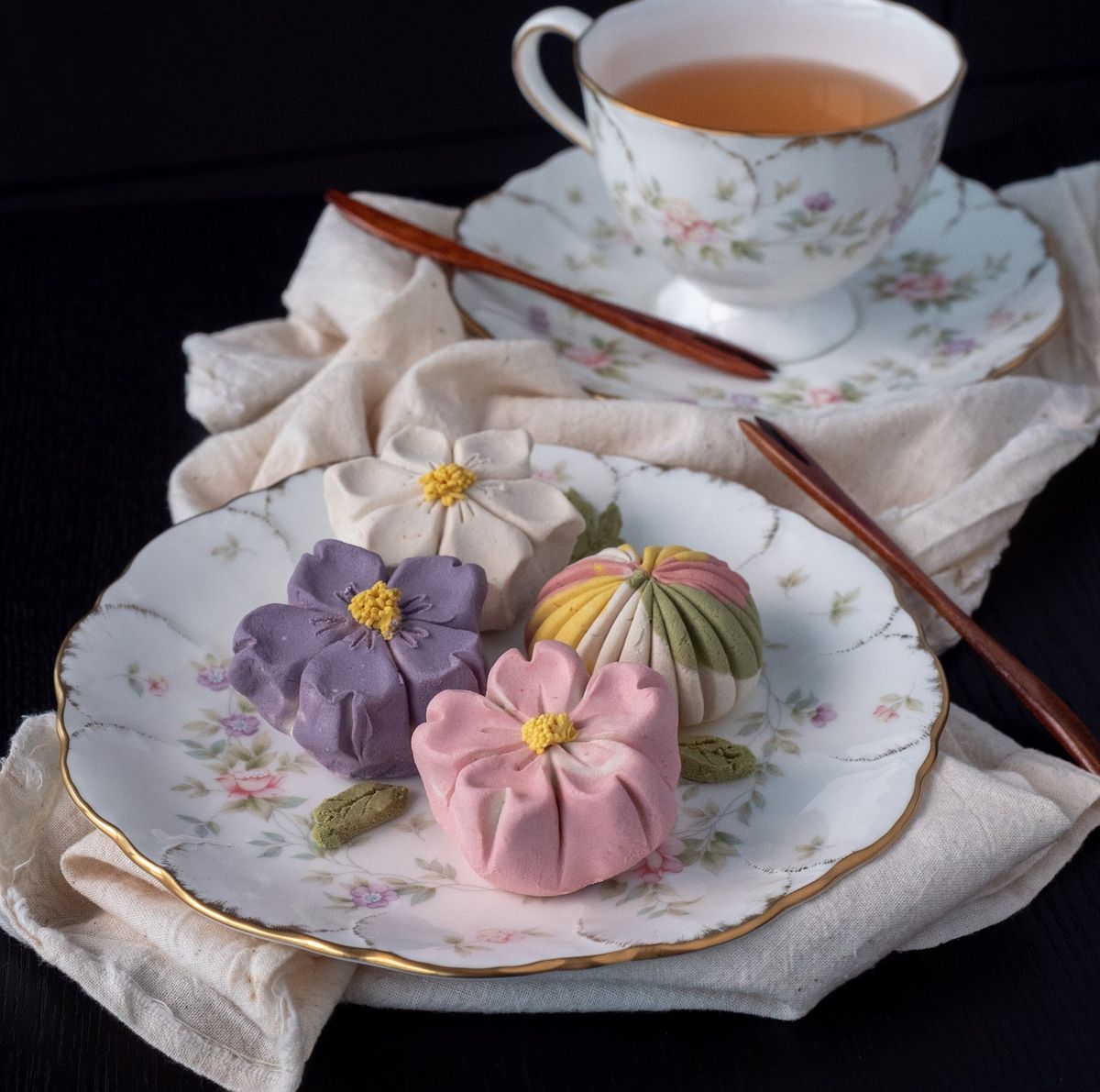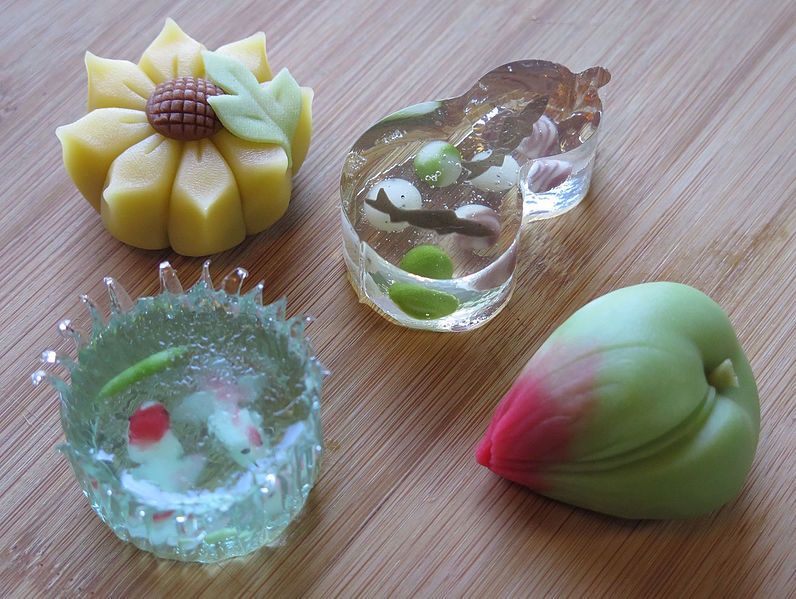Kyogashi: Luxurious Traditional Confection That's Only Made in Kyoto
Indulging in Kyogashi transcends a mere sweet treat; it's a culinary journey rooted in centuries of Japanese cultural and gastronomic traditions. Let's find out how this choice delicacy, once savored by nobles of the Imperial Court, is crafted.

The British scone, a classic companion to tea, finds a parallel in the Japanese Kyogashi, a traditional tea confection.
Unlike the crumbly biscuits synonymous with Western tea sessions, Kyogashi emerges as a colorful, dainty miniature work of art, each piece a unique aesthetic delight.
This traditional sweet, a more exclusive variant of the well-known wagashi, epitomizes confectionery craftsmanship.
Each Kyogashi piece transcends being merely a sweet treat, embodying a visual spectacle reflective of centuries of tradition.
What is Kyogashi?
Kyogashi, often referred to as "Kyoto sweets," are traditional Japanese confections known for their colorful and intricate designs inspired by the country's distinct seasons.
Deeply rooted in the rich tradition of Wagashi (Japanese sweets), each Kyogashi carries a symbolic name, reflecting Japan's cultural and historical essence through its form, hue, and narrative.
More than just a sweet treat, indulging in Kyogashi is a culinary experience steeped in centuries of Japanese cultural and gastronomic tradition, typically enjoyed with a rich cup of matcha green tea, embodying the sophisticated essence of Japanese hospitality.
History and Origin of Kyogashi Sweets
Introduced to sugar and 'sweets' through early trade with China's Sui and Tang Dynasties, Japan's sweet saga began.
The Asuka period (538-710) saw the arrival of Chinese confections, paving the way for a growing sweet tooth that flourished into the Edo era, fostered refined sweet-making techniques, marking Kyogashi's evolution from a noble indulgence to a popular delight in the 17th century, alongside the tea ceremony's ascent.
This shift adorned Kyoto's streets with stalls vending these sophisticated sweets.
Now, Kyogashi symbolizes Kyoto's culinary heritage, with revered spots like Sasaya Iori and Kameya Kiyonaga offering a spectrum of Kyogashi and unique crafting classes, merging tradition with engaging experiences, captivating both locals and visitors.

It's Exclusively Crafted Only In Kyoto
Kyoto, a haven of artisanal mastery, harbors skilled artisans dedicated to the age-old craft of Kyogashi, a traditional confectionery.
Initially crafted from simple ingredients like sugar, rice flour, and bean paste, Kyogashi has blossomed into a spectrum of delightful varieties.
Each Kyogashi piece is a visual ode to Kyoto's rich culture, with artisans meticulously molding and adorning them to reflect seasonal and historical themes of the city.
Though no legal bindings restrict Kyogashi's creation to Kyoto, the term "Kyogashi" epitomizes sweets crafted in this ancient city, a nod to Japan's commitment to preserving regional culinary traditions.
In 1857, the Edo government underscored its royal allure by authorizing only 28 shops to serve these sweets to the Royal Household.
Kyoto's geographical bounty, enriched by a warm climate and surrounded by mountains, facilitates the availability of high-quality ingredients essential for Kyogashi.
The city's matcha, a renowned green tea, often intertwines with Kyogashi, both as a flavor enhancer and a traditional accompaniment, symbolizing a sweet continuum of Kyoto's culinary and cultural legacy.
Harmonious Pairing: Uji Matcha and Kyogashi in the Tea Ceremony
The Japanese Tea Ceremony, more than a tea-brewing ritual, is a heartfelt expression of hospitality and respect.
Each detail, from the tea bowl to the flower arrangement, is carefully chosen to craft a unique experience, with Kyogashi sweetening the ceremonial prelude.
Before the Uji Matcha tea, known for its bitter tang, is sipped, the sweet Kyogashi is served, offering a delightful contrast.
Kyogashi, however, is more than a sweet palate pleaser. It's a seasonal celebration manifest in confectionery form.
How is Kyogashi Made and What Makes It Luxurious??
Crafting Kyogashi is an artful endeavor, melding culinary skill with traditional artistry, often mirroring seasonal aesthetics.
The meticulous journey from raw materials to detailed confections demands adept craftsmanship. Here's a closer look into the Kyogashi-making process:
Ingredient Selection
Primary Ingredients: Adzuki beans and rice flour are commonly used. Adzuki beans are boiled to create a sweet paste called Konashi, while rice flour aids in achieving the desired texture.
Natural Colorings: Natural colorings are employed to mirror seasonal themes, like pink for spring's cherry blossoms or deep red for autumn's foliage.
Preparation
Bean Paste Preparation: Adzuki beans are boiled and pureed to form a smooth paste. This paste is then sieved through a fine-mesh to ensure a refined consistency, creating what's known as Konashi.
Mixing and Coloring: Rice flour is meticulously mixed with the bean paste. Natural colorings are then added to the mixture to achieve the desired hue that resonates with the season or theme.
Shaping and Carving
Hand-Shaping: The mixture is hand-shaped into various forms. The artisan's skilled hands mold the dough into shapes reminiscent of nature, like fruits or flowers, or sometimes more abstract forms.
Using simple wooden tools, they craft each piece with a finesse that reflects the essence of the changing seasons
Carving: Additional detailing may be carved into the sweets to enhance their visual appeal and to adhere to the theme they are intended to represent.
Finishing Touches
Once shaped and detailed, the Kyogashi may be presented with additional adornments or alongside other complementary elements to enhance the overall aesthetic and thematic representation.
Storage and Serving
Depending on the type, Kyogashi may need to be refrigerated or kept in a cool, dry place until ready to be served, often as part of a traditional tea ceremony.
Crafted by Kyoto's Perfectionist Artisans
Kyoto's artisans craft Kyogashi from treasured recipes, a legacy spanning over 17 generations.
Much like other traditional Japanese crafts, confectioners dedicate decades to perfecting their artistry, aspiring for the revered title of master.
Perfection is the benchmark, with anything subpar being instantly discarded.
Kyogashi creation entails using only the finest ingredients, meticulously sieved, mixed, strained, and kneaded to achieve the perfect consistency.
The Main Three Key Varieties of Kyogashi
Namagashi
Namagashi, denoting fresh sweets mainly made from sweet bean paste, contrasts with Higashi, the dry sweets.
It envelops varieties like Mochigashi (rice cake sweets), Mushigashi (steamed sweets), Manju (dumpling sweets), and Yokan (semi-hard bean jelly).
Evolving with Chanoyu (Tea Ceremony), Namagashi is typically served with Koicha (thick matcha green tea) in formal tea sessions.
Their vibrant hues and artistic shapes are enchanting, yet their freshness demands they be savored shortly after preparation due to their 30% water content.
Han-Namagashi
Han-Namagashi represents a category of traditional Japanese sweets, or wagashi, that are known for being semi-moist or half-dry in texture, placing them between the fresh Namagashi and the dry Higashi in terms of moisture content.
Characterized by their rich, syrupy nature, these sweets offer a texture spectrum from gooey to a brittle dryness
Living up to their name, which translates to 'half-fresh,' they beckon a cool storage and are best enjoyed within a week of creation.
Higashi
Higashi serves as a counterpoint to Namagashi, encapsulating drier sweet varieties.
Classic examples include Aruheito (sugar candy), Okoshi (candy-coated cereal crisps), and Rakugan sweets, falling under the Uchimono category (sweets crafted in wooden molds and dried).
In tea ceremonies, Higashi often accompanies Usucha (thin matcha green tea) during less formal settings.
Final Thoughts
Kyogashi, with its thematic resonance, mirrors the host's homage to the shifting seasons. Its growth intertwined with the Tea Ceremony epitomizes a beloved tradition of aesthetic allure and culinary mastery.
Rooted in ageless traditions and a stringent uphold of quality, Kyogashi emerges as a delightful symbol of Kyoto's profound history, delivering a luxurious taste intertwined with a vibrant slice of Japan's cultural richness.
Through its exquisite craftsmanship, Kyogashi convincingly holds the title as a premier sweet, offering an indulgence that's both visually enchanting and gastronomically satisfying.


